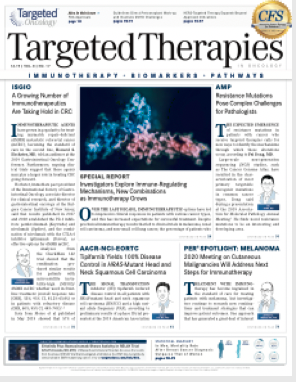Guidelines Direct Pretransplant Work-Up and Illustrate GVHD Challenges
New clinical practice guidelines for HCT have been published by the National Comprehensive Cancer Network. The guidelines provide step-by-step information on best practices in evaluating patients for HCT and managing complications.
Ayman A. Saad, MB/BCH

Ayman A. Saad, MB/BCH
For many patients with cancer,the only known curative option available is hematopoietic cell transplantation (HCT). Unfortunately, the major complication associated with HCT is graft-vs-host disease (GVHD), which can limit the therapy’s success. Making matters more difficult, recognizing and accurately diagnosing GVHD can be difficult because of its of vague, nonspecific symptoms.
New clinical practice guidelines for HCT have been published by the National Comprehensive Cancer Network (NCCN).1The guidelines provide step-by- step information on best practices in evaluating patients for HCT and managing complications. This type of specialized treatment is increasingly common, now used approximately 22,000 times a year in the United States in people with various malignancies, most commonly for blood-related cancers.2
“The field of hematopoietic cell transplantation is a continuously evolving field,” saidAyman A. Saad, MB/BCH, in an interview withTargeted Therapies in Oncology. Because new data continuously emerge and are often published in both international and US journals, the guidelines seek to synthesize these developments, provide a diagnostic work-up, and offer a treatment algorithm to follow when managing patients, he added.
Additionally, Saad said, the guidelines can help train oncology fellows and transplant physicians who are early in their careers. “We hope this will help streamline clinical practices and educate new generations of physicians in training,” said Saad, a professor of clinical medicine at The Ohio State University Comprehensive Cancer CenterThe James Cancer Hospital and Solove Research Institute and chair of the NCCN guidelines panel for HCT.
Pretransplant Evaluation
The first part of the guidelines addresses the importance of the pretransplant evaluation, which focuses on the patient work-up, recommended laboratory testing, and imaging. The possibility of HCT should be brought up soon in the course of treatment. “Ideally, the earlier the better. In fact, it can be as early as the first day of diagnosis, when it’s appropriately indicated,” Saad said.
In 2017, the most common malignancies treated with HCT were multiple myeloma and lymphomas specifically, non-Hodgkin lymphoma and Huntington disease, which accounted for 63% of all HCTs. For allogeneic transplants, acute leukemia (including acute myeloid leukemia and acute lymphoblastic leukemia), myelodysplastic syndromes (MDS), and myeloproliferative neoplasms (MPNs) were the most common, accounting for 72%.
The use of MDS and MPN transplants increased after the Centers for Medicare & Medicaid Services approved coverage with evidence development studies allowing allogeneic HCT in Medicare-insured patients for MDS (since 2010) and will continue to rise with the approval for myelofibrosis in 2017.2
To determine eligibility for HCT, the comprehensive clinical assessment should include a confirmed histologic diagnosis, disease status including cytogenetic/molecular testing for risk stratification, bone marrow aspiration to confirm remission, and results of an electrocardiogram, as well as measurements of left ventricular ejection fraction.
“Two important work-up components that community oncologists should be aware of are pulmonary function tests and the HCT comorbidity index [HCT CI] score,” Saad said. The HCT-CI predicts the risk of nonrelapse mortality after transplant more accurately than age and performance status but does not predict risk of relapse. The HCT-CI calculator is available online (hctci.org/).
Conducting a thorough work-up before referring the patient to a transplant center can save time for both the transplant center and the patient, who might also be spared the costs of travel to the center.
Saad advises practitioners to become familiar with the pretransplant recommendations. “Community oncologists will have a better idea of what transplant physicians consider when we see a patient to determine transplant eligibility,” Saad said. “It sets up the whole treatment team to be on the same page.”
During the pretransplant phase, the following laboratory tests should be requested: complete blood test with differential; ABO/Rh blood-type testing; chemistry profile; urinalysis and toxicology screening in high-risk patients; testing for infectious disease, including hepatitis and HIV; and human leukocyte antigen (HLA) typing.
A chest x-ray is recommended, especially for patients who have had chronic neutropenia, to rule out occult pneumonia infection. “If the patient has been neutropenic for 3 months, for example, we want to also rule out an occult fungal infection in the chest,” Saad said.
Further evaluation, if clinically indicated, includes a pregnancy test in women of child-bearing potential, physical therapy evaluation, and nutritional evaluation, thyroid-stimulating hormone level, and iron profile.
GVHD
“GVHD is one of the most notorious complications of allogeneic transplantation,” Saad said. “It is important for the community oncologist to recognize the signs of GVHD.”
The recipient’s age, conditioning regimen, hematopoietic graft source, and GVHD prophylaxis affect the frequency of this complication, which is fatal in about 15% of patients.3 Steroids are the standard first-line therapy, but patients who develop steroid refractory acute GVHD (aGVHD) have poor outcomes, as long-term mortality rates approach 90%.4 “Once steroids have failed, there is no consensus on treatment options,” Saad said.
In patients who undergo an autologous HCT, the most commonly reported cause of death is primary disease, at 71% (FIGURE 1).2 In siblings who are HLA-matched and undergo trans- plant, within the first 100 days, primary disease accounts for 29% of deaths, whereas infection and organ failure represent 37% of deaths. Fifty-seven percent of deaths are attributed to primary disease at or after 100 days post-transplant (FIGURES 2and3).2
Acute GVHD
Acute GVHD is characterized as grade 0, I, and II-IV, with stages determined by organ-directed biopsy. Common symptoms are skin rash, diarrhea, nausea, and vomiting. A gastrointestinal (GI) biopsy or stool test may be used to rule out other causes of GI symptoms. Liver biopsy should be considered if liver function tests reveal elevated enzymes.
“Acute GVHD often appears within 3 months (conventionally described in the first 100 days) of the transplant and it often affects the liver, the gut, and the skin,” said Saad. “Some cases arise later posttransplant and that’s called delayed aGVHD.”
For rash, the guidelines recommend a topical steroid and continued use of the original immunosuppressive agent; for later grade aGVHD (grade II-IV), consider continued use of an immunosuppressive agent, systemic corticosteroids, or clinical trial.
Chronic GVHD
“I recently saw a patient who was having difficulty breathing posttransplant. Although [the patient was] diagnosed with asthma, itturned out that it was chronic GVHD of the lung,” said Saad, which illustrates that chronic GVHD (cGVHD) poses a challenging differential diagnosis.
The chronic version of GVHD is classically defined as occurring after the first 100 days posttransplant. What distinguishes cGVHD from aGVHD is its characteristic presentation, which resembles an autoimmune vascular disease. Tissue pathology and specific diagnostic criteria also aid in the differential. This form occurs in 30% to 65% of allogeneic HCT recipients. Its 5-year mortality is 30% to 50%, attributed to immune dysregulation and infections.4cGVHD targets the skin, subcutaneous connective tissue, oral mucosa, salivary and lacrimal glands, the lungs, gut, liver, and joints (TABLE). It is highly debilitating.4
First-line treatments for cGVHD include systemic corticosteroids, topical steroids, inhaled steroids, and continued use of an immunosuppressive agent, as well as joining a clinical trial, especially if the patient does not respond to steroid therapy. “Enrollment in well-designed clinical trials should be encouraged, since no standard, effective therapy for steroid-refractory GVHD has been identified,” the guidelines state.
In conclusion, “We hope all community oncologists become familiar with the criteria to determine eligibility for transplant,” Saad said. “In addition, they should familiarize themselves with the varied manifestations of GVHD, particularly chronic GVHD because [its symptoms can be] nonspecific.”
References
- NCCN Clinical Practice Guidelines in Oncology. Hematopoietic Cell Transplantation (HCT): Pre-Transplant Recipient Evaluation and Management of Graft-Versus-Host Disease, version 1.2020. National Comprehensive Cancer Network website. nccn.org/professionals/physician_gls/pdf/hct.pdf. Published October 30, 2019. Accessed November 19, 2019.
- D’Souza A, Fretham C. Current uses and outcomes of hematopoietic cell transplantation (HCT): CIBMTR summary slides. Center for International Blood & Marrow Transplant Research website.cibmtr.org/ReferenceCenter/SlidesReports/SummarySlides/pages/index.aspx. Published 2018. Accessed November 19, 2019.
- Pasquini MC, Wang Z, Horowitz MM, Gale RP. 2010 report from the Center for International Blood and Marrow Transplant Research (CIBMTR): current uses and outcomes of hematopoietic cell transplants for blood and bone marrow disorders.Clin Transpl. 2010:87-105.
- Blazar BR, Murphy WJ, Abedi M. Advances in graft-versus-host disease biology and therapy.Nat Rev Immunol.2012;12(6):443-458. doi: 10.1038/nri3212.

Survivorship Care Promotes Evidence-Based Approaches for Quality of Life and Beyond
March 21st 2025Frank J. Penedo, PhD, explains the challenges of survivorship care for patients with cancer and how he implements programs to support patients’ emotional, physical, and practical needs.
Read More